🐺 The Siberian Husky - more than just a beautiful dog

Anja Nehrenheim
🐺 The Siberian Husky - more than just a beautiful dog
A technical article with heart, history and lived experience
The husky who found me
For many, the Siberian Husky is a beautiful, wild dog with icy blue eyes. For me, he is much more: a teacher, life companion and motivator, especially on my journey with MS. This article is more than a portrait of this breed - it is a tribute to its history, its abilities and the deep connection between man and dog.
Origin & history - From ice to endurance legend
The Siberian Husky originally comes from the Chukchi, an indigenous people in Eastern Siberia. They have been bred there for centuries as draught animals for hunting and trade. The decisive factors were:- Endurance over long distances
- Robustness in extreme cold
- Social behaviour in the pack and with people
Strangers were welcomed in a friendly manner by the Chukchi - a guard dog would not really have fitted in. Instead, the husky developed into a friendly, sociable companion, who also liked to serve as a hairy hot water bottle at night.
His physique is athletic, his movements elegant, his coat a double coat of undercoat and topcoat that protects him from the cold - and turns our house into a wool factory in spring.
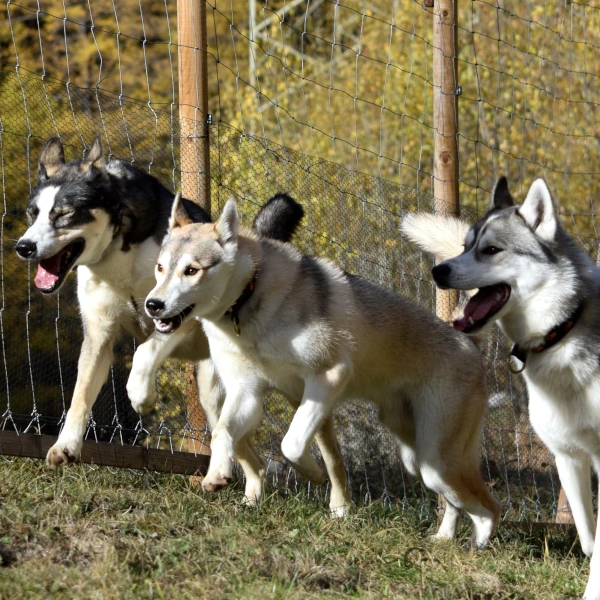
Rwin, Bowie and Yakari the three musketeers
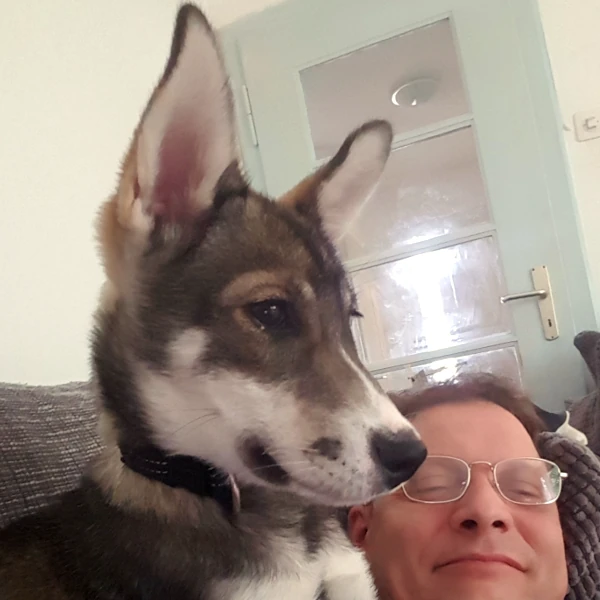
Rey cuddling on the sofa
Myths about huskies - What's really true
There are many misconceptions about the Siberian Husky - some romantic, some simply wrong. Here are the most common misconceptions:
"Huskies are wolves or wolf hybrids" ❌ No. Although they look wolf-like, they are not genetically more closely related to wolves than other dog breeds.
"Huskies need exercise around the clock" ❌ Huskies are active - no question about it. But with a clear structure, mental utilisation and targeted exercise, they are balanced. They don't need 8 hours of action a day, they need smart utilisation.
"Huskies are not trainable" ❌ They are intelligent - they just think for themselves. They question commands instead of blindly following them. Not disobedience, but character.
"A husky cannot be kept alone" ❌ Huskies are pack animals - yes. But with plenty of human contact, structure and exercise, even a single husky can live happily.
"Huskies never freeze" ❌ They are adapted to the cold - but not invulnerable. Wetness, wind or illness can affect them, especially older animals.
"Huskies don't bark, they just howl" ❌ They are very vocal. Howling, whining, talking - and yes, barking is also part of their communication.
"Huskies are perfect jogging partners" ❌ Only to a limited extent. Huskies prefer to pull rather than trot alongside. Ideal for canicross, bikejoring or sledging - for jogging on a lead? Only some.
Character & attitude - The charming free spirit
A husky is not a beginner's dog. And definitely not a hoover friend.
- He is active, playful, clever and stubborn
- He loves running - preferably a lot and for a long time
- Fetch sticks? Only if there's food for it
- Hunting instinct? Clearly present - rather risky without a lead
He wants to be challenged not only physically, but also mentally: Search games, obstacle courses, brain teasers - the main thing is that it challenges him (and there is a reward).
Huskies enjoy working in a team, but also show impressive independence. They need their humans - but not as recipients of orders, but as partners at eye level.
Word origin & language in transition
The word "husky" comes from the English nickname "huskimos", a term for Arctic Inuit peoples. This gave rise to "husky" - later used for their dogs. The term was adopted by settlers - no longer ethnically, but as a synonym for Nordic draught dogs.
An example of how language changes - sometimes unconsciously, often with a colonial context in the background.
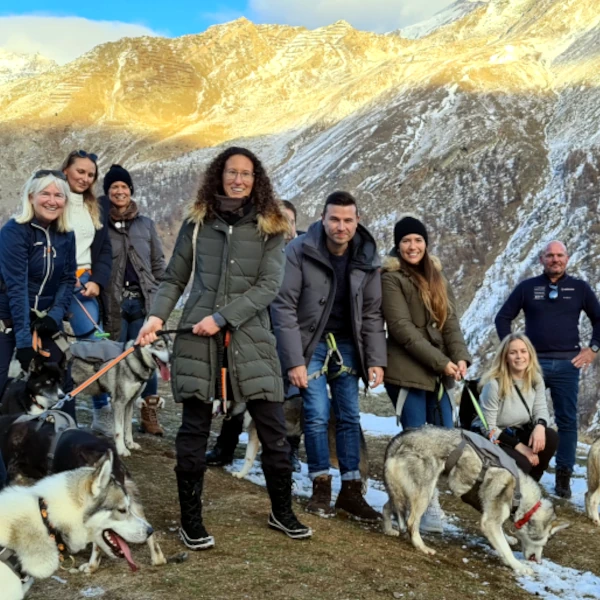
Team trekking tour in the Saas Valley
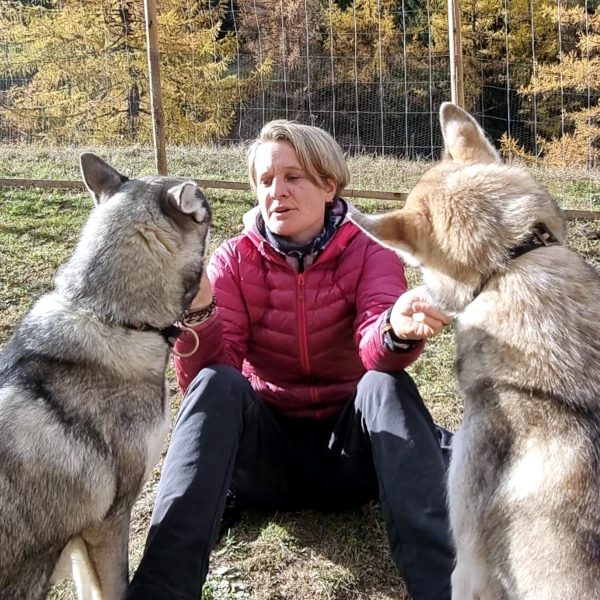
Exercises in the run, with treats of course
Moving to America - From mockery to legend
At the beginning of the 20th century, the Russian fur trader William Goosak brought the first huskies to Alaska - to take part in the famous All Alaska Sweepstakes.
The dogs were much smaller than the Malamutes they were used to - and were derided as "Siberian Rats". However, their speed, endurance and team spirit won them over - and the husky began its triumphal march.
The Norwegian Leonhard Seppala later took over a team from this line, won the Sweepstakes several times - and became famous for the Serum Run to Nome.
The Serum Run - courage, snow and 1600 kilometres
1925: A diphtheria epidemic breaks out in Nome, Alaska. No aeroplane or train can deliver the vaccine - because of ice and storms. So they send out 20 mushers with 150 dogs.
A 1600 km long relay race begins. Temperatures: up to -50 degrees Celsius - Leonhard Seppala runs the toughest and longest stage with his lead dog Togo: over 420 kilometres.
- Gunnar Kaasen brings the vaccine to the finish with Balto (85 km).
Balto became world-famous - his statue now stands in New York's Central Park.
The husky became a symbol of courage, endurance and co-operation.
The Husky today - athlete & family member
Even today, Siberian Huskies live in remote regions as transport dogs. But they are also gaining fans as family dogs - provided you know what you are getting yourself into:
- Not a flat dog
- No guard
- But a very loyal friend if you are prepared to move, learn and be amazed
Our huskies are part of the family. We don't hunt through the ice desert, but we live in the Alps - and they run as if they were born to keep us moving.
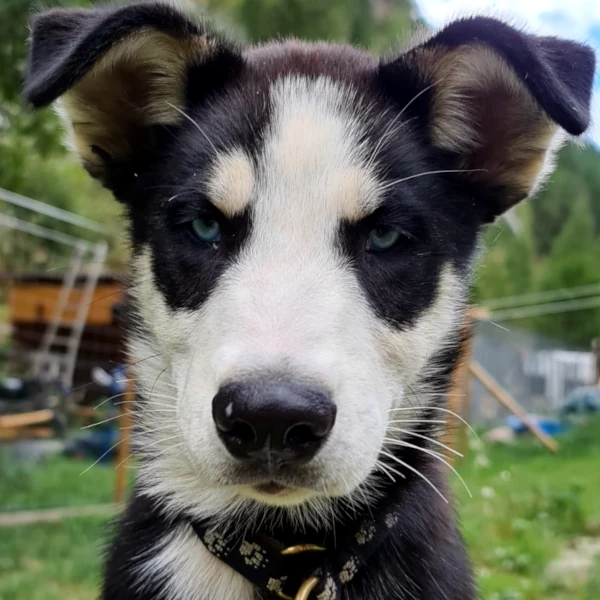
Jagger's look is still world class today
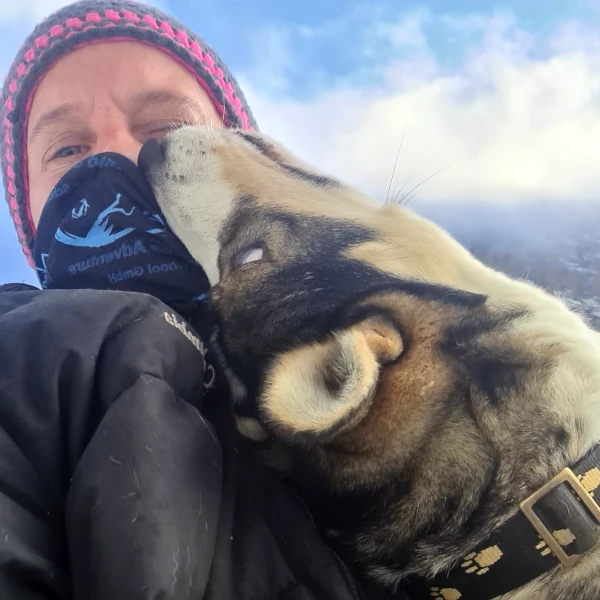
Cuddling time is also a must
What I have learnt about MS and life from huskies
Living with MS means renegotiating boundaries. Every day. And the huskies show me how:
- Endurance instead of speed - you run at a steady pace, not sprinting. It's about persevering, not winning.
- Using energy sensibly - A husky knows its powers. I'm learning to listen to my body.
- Pack spirit - you need clear communication & closeness. I also need people who understand and support me.
- Independence with a bond - the husky is free, but loyal. I can be autonomous - without being alone.
- The joy of the moment - snow, wind, a glance - they celebrate the now. And teach me to do the same.
Conclusion - A dog that not only pulls, but carries
My huskies, with all their idiosyncrasies, are not pets - they are my companions, mirrors and teachers. They show me that a body with limitations can still be powerful, proud and alive.
Life with them is not always easy. It's cold, challenging, sometimes lonely. But it is real.
And with them I know:
My path may not be perfect - but it is free. And despite everything: beautiful.
Husky stories
Existing contributions

Anja Nehrenehim
Anja is the founder of Wild Swiss Adventure and lives with 16 huskies in Eisten in Valais.

